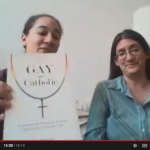
There was a request in the comments that I do a post on Transgender issues in the same way I did a post on bisexuality for National Coming Out Day (which was followed by bisexuality Q&A and a post on queer political tactics). I thought those posts prompted some pretty helpful discussion, so I’m glad to set up another opportunity to go over the basics, but this time I have to tag on some major caveats:
- I’m not trans (well, except transhumanist), so I’m not speaking from a place of personal experience. I really recommend that if you’re trying to learn more about the trans movement or the trans experience, you check out some personal narratives online, because I’m just speaking with all the authority of reading and talking a lot.
- Err, remember that bit about my being bisexual? Some bisexual people are attracted to both men and women and think of them as two sharply divided categories. Some bi folks (including me) think of gender as something you do not something you are. We see the whole thing as a bit of a blurry spectrum and aren’t that interested in how people choose to divvy it up into categories. This tends not to be the position of most trans people.
- Err, remember that bit about my being transhumanist (and/or dualist and gnostic)? My attitudes about the body as a flawed interface for the mind, something decidedly not sacred and acceptable to alter kinda mesh with the transgender perspective, but it’s probably outweighed by my apathy towards the body as intimately bound up for identity.
All that is mainly to say that if the transhumanist movement were looking for spokespeople, I wouldn’t be high on the list. Let me just give a rundown of the basics, and I’ll try to recruit some friends to help out in the comments.

People who are transgender have a strong subjective feeling that their physical body and their self are mismatched. Some people address this discrepancy by crossdressing privately, some people choose to publicly identify with the gender they ought to have, and may have gender reassignment surgery or hormone treatments to bring their mind and body back into harmony.
Surgery is one way to sync these systems up; it’s not a prerequisite for identifying as trans and not all trans people plan to transition medically. No one is “not really trans” because they haven’t used medical or surgical means to change their body just as no one could be dismissed as not really having Body Integrity Identity Disorder (BIID) just because they hadn’t amputated the offending limb.
BIID is one example of a different condition where someone is not at home in his or her body. We take that connection as natural, so it’s hard to imagine how strange and upsetting it would be to have a constant feeling that part of your body was alien to you and hideously mismatched. People who doubt the self-reports of trans people might be persuaded by a common apologetic argument in Christian circles. The evidence for the sincerity of the martyrs lies in their martyrdom. The evidence for the claims of trans people lies in the lengths to which they are willing to go to restore their bodies to they way they think they are meant to be.
Trans is a big category, and, because it’s tangled up in a broader fight about gender, there are a lot of conflicting perspectives inside the community. There isn’t a canonical way to use pronouns, so check with the person you’re talking to. The best default is using the pronoun of the trans person’s self-reported gender, not biological sex at birth. That guideline applies even if you’re using the past tense and are talking about the period before a trans person was out or began any hormonal or surgical intervention. Most trans people see their gender as constant; there is no period when a Female-to-Male trans person was female, just a period where a man presented as female to the outside world. Some people eschew gendered pronouns altogether, and the burden is on them to let you know their preference.

Gender presentation is complicated. In the LGB community, there’s recreational crossdressing that’s disjoint from gender identity and there’s also a history of gender confusion and strategic crossdressing. When queer people were invisible, if you’re female and strongly attracted to women, it might be hard to feel like you belong in the category of women. In the modern U.S. you’d be less likely to have this problem. Finally, people have crossdressed throughout history in order to enjoy the privileges of the opposite gender. My favorite go-to example are the sworn virgins of Albania, but you can include all the women who passed as men to fight in wars, and plenty of others.
So, the TL;DR takeaway is: being trans is fundamentally about feeling like your biological body and your self are mismatched with regard to gender. Crossdressing, hormones, and surgery are common ways people resolve this mismatch, but they’re not compulsory and are not exclusively used by trans folks. Trans people are severely at risk for bullying, assaults, and suicide, due to intense stigma, isolation, and limited legal protection from discrimination.











